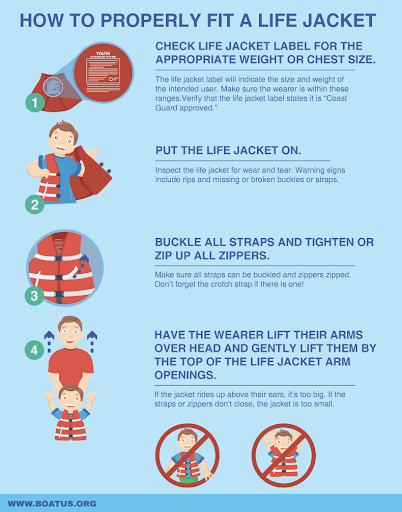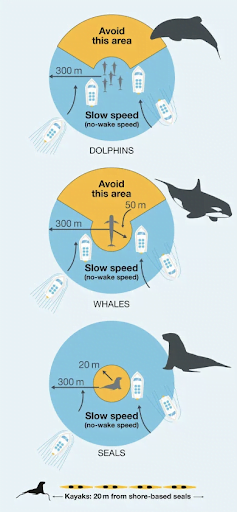We know how much Kiwis love playing in and around the water in the summertime.
We flock to our favorite beaches to swim, surf, paddle board, kayak, sail, water ski and more so it’s safe to say we are a nation of water lovers.…we may even do a once-in-a-lifetime swim with a certain marine mammal found here on Banks Peninsula. But whatever it is we like or want to do……..
Nothing is more important than safety when it comes to our oceans in Aotearoa.
So we have filled this blog with heaps of helpful tips. Water safety comes in two forms that we’ll cover: safety for you and safety for our ocean environment.
Safety for you on the water
When you’re on your vessel, you have sole responsibility for yourself and others’ marine safety. If your vessel is smaller than 4.8 metres, everybody on board must wear a lifejacket at all times. Make sure everyone’s life jacket fits using the graphic pictured here. Even on bigger vessels, make sure you have plenty of life jackets for every size to hand. Lifebuoys are also great when someone goes overboard, as pictured below.
Another extremely important aspect of boat safety is obeying speed limits. You must only go 5 knots when:
- within 200m of the shore
- within 200m of any structure
- within 200m of a boat displaying a diver’s flag
- within 50m of any other boat
- within 50m of a person swimming
- on a powerboat, if any person has any part of their body outside the rails or edge of the deck.
It’s good to know that when you’re aboard a Black Cat vessel, you’re in the safe hands of a MTOC accredited operator. What does that mean? We’ve been through the rigorous process of gaining certificates of approval from Maritime NZ. That means they’ve agreed we have a capable and well-trained crew, we have managed risk hazards, our boats are running smoothly, and we know what we’d do in an emergency.
It’s a very good idea to keep clear of large vessels. They aren’t any good at quickly moving out of your way.
The Maritime website has everything you need to know about boat safety if you want to know more and here is a great visual guide on how to fit a life jacket safely.

General water safety rules you should always follow
Whatever you’re doing on the water, there are some universal tips to keeping safe.
Assess the conditions before heading out there.
Plan ahead and check the weather and wind forecast. It’s usually the WIND AND SWELL that can cause the biggest problems. A great free website or app for this is Windy. If it’s stormy or super windy, and the water is really choppy, don’t go out. If it’s getting dark, don’t go out there.
A great option is to GO WITH A FRIEND and have some way of communicating some-one on land. If you are going out alone tell someone responsible where you are going and what time you expect to be back.
You should also DRESS APPROPRIATELY, WEAR AN OCEAN FRIENDLY SUNSCREEN….and when taking part in any water sports ALWAYS WEAR A LIFEJACKET. Even in summer, hypothermia can still happen. New Zealand’s water isn’t tropical and the water gets colder the further out you go, or when you’re in the water for long enough.
 If you ever get caught in a strong current or ‘rip’ DO NOT PANIC. Let yourself be carried by the rip as it won’t go forever. This way, you won’t exhaust yourself fighting against it. Once you stop getting carried, you can swim or paddle around the tip and safely get to shore. If you are swimming on a beach that is patrolled by lifeguards try to raise your arm if you can so you can hopefully get spotted and have one of the amazing New Zealand Surf Life Savers come to your rescue.
If you ever get caught in a strong current or ‘rip’ DO NOT PANIC. Let yourself be carried by the rip as it won’t go forever. This way, you won’t exhaust yourself fighting against it. Once you stop getting carried, you can swim or paddle around the tip and safely get to shore. If you are swimming on a beach that is patrolled by lifeguards try to raise your arm if you can so you can hopefully get spotted and have one of the amazing New Zealand Surf Life Savers come to your rescue.
To upskill yourself in and around the water you could always join one of your local Surf Life Saving clubs. They have regular training sessions and best of all children can enroll from the age of 7 so they can help educate the next generation of young Kiwi’s on water safety. They even have a great page on how to stay safe at the beach any time of year which you can find here.
Safety for the environment

New Zealand is a beautiful country, and we’re pretty good at keeping it that way. But we all need a reminder every now and then, and we have to keep at it every time we’re outside. Black Cat Cruises is also a SMART operator, and that’s not just us tooting our own horns. It means we are part of a voluntary collaboration between DOC and commercial vessels that are involved with marine mammals. DOC gives us guidelines to make sure we minimize our impact on their natural processes. The principles are carried to all marine life in Akaroa, from the little blue penguin and the fur seal to our beloved Hector’s Dolphins (and any other visits we get from Orcas or Humpback whales!)
You can also follow these guidelines.
- If you see another vessel near a marine animal, keep clear and wait for them to leave before approaching.
- NEVER feed a marine animal.
- Move very slowly and do not circle.
- Don’t swim with dolphins that have juveniles (half the size of an adult or smaller).
- Onshore, keep dogs on leashes near seals and give them space.
- Don’t get between a seal and the sea.
Also, keep a lookout for any vessel (fishing, commercial or private) which looks like it’s breaking the rules. You can report anything suspicious to 0800 DOC HOT (0800 362 468).
For more tips, have a look at DOC’s article here.
Finally, as the good saying goes; take only photographs and leave only footprints. But if you’ve made it this far through reading our blog, we already know you will.
You can always take it that next step further and pick up any rubbish you see on the shores.
Keeping all of this in mind, along with some common sense, will make sure you, and everybody else, has a safe and awesome summer.
Why not make it even more awesome with Black Cat Cruises. Visit our website to book from one of our wonderful award-winning water based experiences!
Written by Josh Bingham
